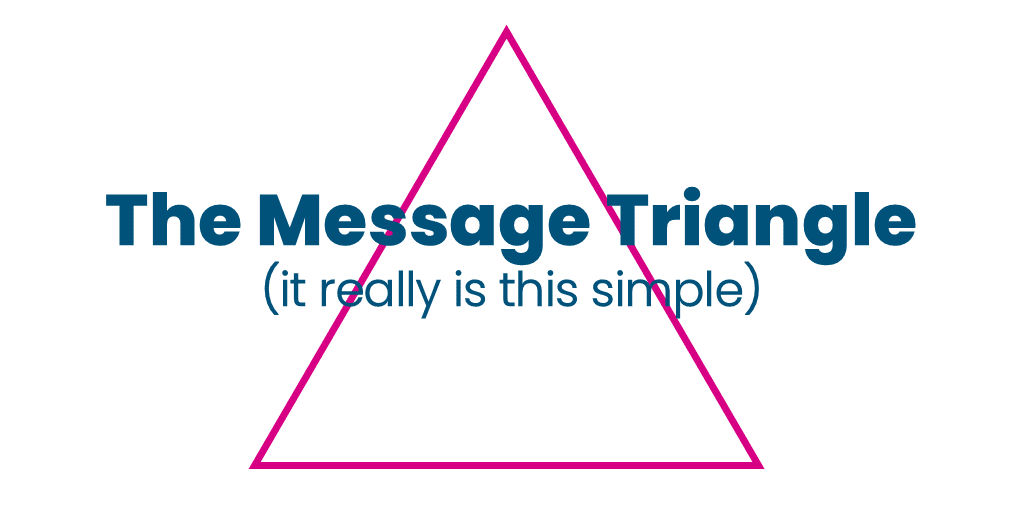
Keep your message triangle on replay
Whether you talk to the media weekly or once in a blue moon, you should have a trio of top-level messages on replay.
Lowe Group public relations and content services clients are well aware of message triangles. Crafting and shaping these core media messages for our investment firm clients has been a foundation of our work since 2003.
Why? In the incredibly fast-moving investment world, people are inundated with information. To break through the clutter, you need to constantly repeat the most salient, differentiating points about your firm. Repeat. Repeat. Repeat.
These messages are critical to reinforcing your brand for your clients and potential clients. They also help get the “what” and “why” of your firm before existing and potential employees and your sources of capital/funding.
Those three key points—what we call a message triangle—keep you focused when you are talking to a reporter. If it’s a phone call, have the three points in front of you, written out in an actual triangle. Like “ready to wear” clothes, these are “ready to say” words about your firm.
Shaping your messages
 Here’s an example of one top-level message for an asset manager focused on sustainable investments:
Here’s an example of one top-level message for an asset manager focused on sustainable investments:
“No company is perfectly good or perfectly evil. Our job is to find outstanding investment opportunities among companies working hardest to be responsible.”
Note the following about that high-level core message:
- It differentiates the firm in the competitive landscape—in this case, with a clear implication that not every sustainable-investing asset manager has the same philosophy.
- It’s quotable as stated.
- Its appearance in a news story would be positive branding for the company.
Another core message for a small cap manager:
“In our analysis of thousands of companies each year, we scour financial statements looking for companies that can compound earnings more than 20% each year over time.”
Note the following about this message:
- It reflects the company’s diligent efforts to find fast-growing companies.
- It offers a specific and memorable measure (20%) of what growth means.
- It’s quotable as stated and could benefit from a few examples (adding subpoints with examples for a specific interview)
Not vision, mission, values…
Your firm may have—whether published or not—a mission statement, brand promise or any number of other central messages about your purpose or your products or services. Media-facing messages harmonize with these. But a “vision statement,” say, can’t actually be one of your key points in media interviews.
That’s because a vision statement, as an aspirational objective, lacks of-the-moment salience that feeds journalists with material for stories.
Crafting high-level core messages for the media
Here are a few suggestions for whittling down and actually writing out your core media-facing messages.
- Aim for three points, each of which is truly different from one another. The reason for three—a triangle, not a square or pentagon—is that you can cover only so much in an interview. Three key ideas give you enough to work with but not too much to get lost in. Also, the ultimate audience, those reading or taking in the publication, can take in and remember only a few things. Keeping to three points increases the likelihood that people retain and remember what makes you different.
- Create subpoints for each main point that support, restate, clarify or expand on your main point. These will help you clarify your point and address follow-up questions. They also provide examples or alternative phrasing when creating a news release or other communication that touches on the theme.
- Try not to get too granular or product-specific. If you address products or services, do so in the context of the firm overall. (You can create a separate message triangle for a new product launch or announcement.)
- Know it’s OK to leave out topics that come to mind as important but not salient. This exercise is about what’s useful and interesting to reporters—not just what describes your firm.
- Ask yourselves—and others internally—whether anything is missing. Is there an elephant in the room that you failed to address or capture in your message triangle?
- Remember that this is meant to guide how you talk about your company. No need to get every word just right. Take great care in the phrasing of the top-level points, but don’t sweat too much the precise language of the supporting points that add more detail or nuance. Remember this is an internal-only tool meant to support oral communication. People will say the words slightly differently no matter how you write them. But you want your team to coalesce around the top-level points.
Next steps
Once you have your message triangle in good order, it’s time to put it to good use—with media interactions and in other contexts, too. When drafting a news release, refer to your message triangle and use it to help shape quotes from executives or write descriptive copy. When doing interviews, your message triangle is a useful tool that can keep you focused on delivering the key points about your company—and avoid rambling on less important points. The best spokespeople come back to the same points, repeating them regularly and helping to reinforce brand positioning.
Subscribe.
Receive the latest news and insights from Lowe Group.